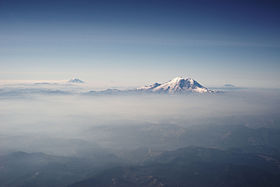Cascade Range
| Cascade Range | |
|---|---|
 The Cascades in Washington, withMount Rainier,the range's highest mountain, standing at 14,411 ft (4,392 m). Seen in the background (left to right) areMount Adams,Mount Hood,andMount St. Helens. | |
| Highest point | |
| Peak | Mount Rainier |
| Elevation | 14,411 ft (4,392 m) |
| Coordinates | 46°51′1.9″N121°45′35.6″W/ 46.850528°N 121.759889°W |
| Dimensions | |
| Length | 700 mi (1,100 km) north-south |
| Width | 80 mi (130 km) |
| Geography | |
| Countries | United States and Canada |
| Provinces/States | British Columbia,Washington,Oregon,andCalifornia |

TheCascade Rangeis amountain rangein westernNorth America.It goes from NorthernCalifornia,throughOregonandWashington,and ends inBritish Columbia,Canada.The range includes theWestern Cascadesin northern California and theNorthandCanadian CascadesinWashington Stateand Canada.
The Cascades arein thePacific OceanRing of Fire,the ring ofvolcanoesand associated mountains around the Pacific Ocean.Volcanosin the range includeMount St. Helens,Mount Rainier,andMount Shasta.The Cascades are part of the "American Cordillera",the almost continuous spine of mountains which runs right down the western side of theAmericas.
The highest mountain in the cascades isMount Rainierat 14,411 feet or 4,392 metres.
Geology
[change|change source]The Cascade range was formed by thousands of small, short-lived volcanoes that built a platform oflavaand volcanic debris. Rising above this volcanic platform are a few strikingly large volcanoes, likeMount St. Helens,that dominate the landscape.[1]
The fundamental reason for all these mountains on the western side of the Americas is the steady movement of the great landmasses away fromEurasiaand Africa. The process ofcontinental driftis fuelled by the production ofsea-floormaterial at themid-Atlantic trench.The landmasses of the Americas have buckled the edges of the Pacific plates, resulting in the continual volcanic build-up of mountains on the western side of the continents. TheCascade Volcanic Arcmade its first appearance 36 million years ago. The major volcanic peaks today were born in the last 1.6 million years. More than 3,000 vents erupted during the most recent volcanic episode that began 5 million years ago. As long assubductioncontinues, new Cascade volcanoes will continue to rise.[1]
As the oceanic slab sinks deep into the Earth's interior beneath the continental plate, high temperatures and pressures allow water molecules locked in themineralsof solid rock to escape. The water vapor rises into the pliable mantle above the subducting plate, causing some of the mantle to melt. This newly formedmagmarises toward the Earth's surface to erupt, forming a chain of volcanoes.[1]
References
[change|change source]Other websites
[change|change source] Cascade Mountainstravel guide from Wikivoyage
Cascade Mountainstravel guide from Wikivoyage Media related toCascade Rangeat Wikimedia Commons
Media related toCascade Rangeat Wikimedia Commons

